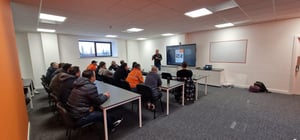Oakley Capital Investments Limited (LON:OCI) is the topic of conversation when Hardman and Co’s Analyst Mark Thomas caught up with DirectorsTalk for an exclusive interview.
Q1: Your recent report on Oakley Capital Investments sits behind a disclaimer. What can you tell us about that?
A1: It is just the standard disclaimer that many investment companies have. In essence, for regulatory reasons, there are some countries (like the US) where the report should not be read. In the UK, private equity (PE) is not a simple asset class, and it should only be looked at by professional/qualified investors. Page 2 of the report gives all the details.
Q2: You called your recent piece Capital Markets Day 2022 – let the sun shine. What can you tell us about that?
A2: It was a pretty miserable, wet day in May, when OCI held its Capital Markets (CM) Day; so we called our note Let the sun shine. The underlying theme of the day was explaining the business model, which means OCI delivering its impressive market- and peer-beating 19% NAV CAGR growth 2017-21 (6% alone 1Q’22), and why this growth should be sustainable going forward.
At its core is an investment focus on structurally high-growth areas, combined with a unique proprietary network originating deals. Once a business has been acquired, value is then added through business transformation (e.g. digitalisation), performance improvement, leadership development and buy-and-build strategies.
Oakley Capital’s expertise incrementally improves investee companies. Investors are buying into this sustainable, long-term model, not just the current attractive portfolio. OCI structured the day with an introduction to the group, followed by sector reviews of its investments in the education, technology and digital consumer sectors, and then followed by a session on ESG, a NED overview and a short Q&A session.
Q3: So, what did the group overview tell us?
A3: The key takeaways were i) 19% five-year NAV CAGR, driven by earnings growth in investee companies, ii) a diversified and resilient portfolio, iii) long-term commitments covered by cash, iii) likely near-term realisations of investments that have already been held for three years or more, iv) the valuation approach, and so the NAV, having proved to be conservative, v) multiple actions taken to address the discount, and vi) OCI expects further growth, despite market headwinds.
It was an interesting and refreshing approach in that OCI directly took on market concerns on things like the valuation of technology companies – no holds barred, heads straight over the parapet, so to speak.
Q4: And what did you learn about its education investments?
A4: We had already reviewed these investments in some detail in our report, Educating on education, published on 9 February 2022. One of the key points to take away from the CM Day was the brand value of being a “Responsible Custodian”.
Additionally, with the education market growing strongly and with highly attractive, resilient income streams, there are limited listed opportunities, and Oakley Capital is a leading private market player. OCI gave a really interesting case study of IU Group, its largest investment, at 17% NAV, and now a global provider of degrees and wider education services.
Q5: What about its technology investments?
A5: Technology has been the best-performing PE sector in past decade, and, in our report, we outline why many of the key drivers that led to that performance remain intact. Adoption of new technologies will also drive growth, and Oakley Capital is focused in sub-sectors with the fastest growth prospects. Oakley Capital also detailed why it believes its valuation approaches in technology are conservative. The investee company presentations re-emphasised the business driver themes of structural growth, and how Oakley Capital enhances the businesses.
Q6: And, finally, the digital consumer investments?
A6: The focus is on digital consumers, because this area offers superior structural growth, but not all the sub-sectors are the same. OCI is focused in under-penetrated markets, where there are scalable unit economics and where it can improve revenue quality, and also enhance iconic brand business models. The emphasis was that, even in challenging markets, there are opportunities with the right approach that may include things like a buy-and-build model.








































